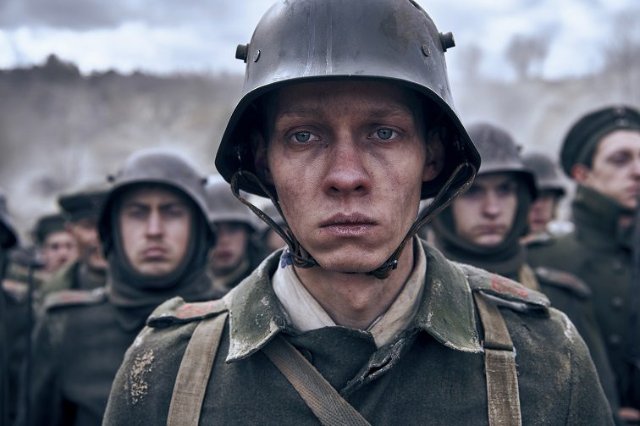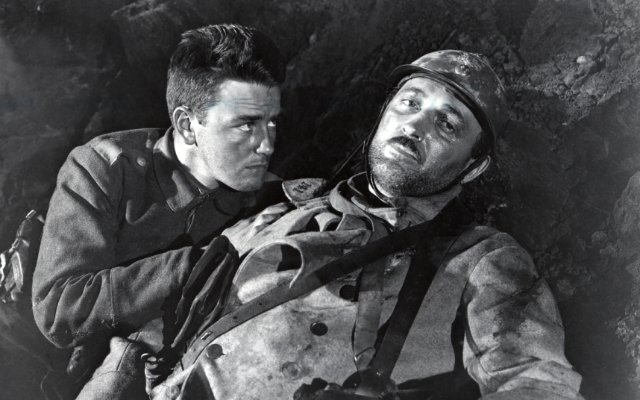All Quiet on the Western Front
German Director Edward Berger Remakes 1930 Double Oscar Winner.
By: Charles Giuliano - Oct 30, 2022
All Quiet on the Western Front
Director, Edward Berger
Writers, Edward Berger, Lesley Paterson, Ian Stokell, Erich Maria Remarque (novel)
Stars: Daniel Brühl, Albrecht Schuch, Sebastian Hülk, Felix Kammerer, Edin Hasanovic
Running Time 2h 27m
Available on Netflix
The 1929 novel “All Quiet on the Western Front” by Erich Maria Remarque humanized WWI by following the fate of Paul Baumer and his classmates. They rushed to enlist and fight for the Fatherland following a speech by Professor Kantorek.
Filled with sanguine patriotism and a mantra of “two weeks to Paris,” during training under the brutal Corporal Himmelstoss, they bonded. drilled and sang patriotic songs.
Arriving at the chaotic Western Front, where three million will perish, they soon experience the reality of combat and carnage. It was not the glory they had been led to anticipate. Ultimately, the war claimed 17 million lives.
The riveting, realistic, narrative, which I read as a teenager, is arguably among the most poignant and enduring anti-war novels of all time. So soon after WWII it seemed disorienting to me that these young German soldiers and their ordeal aroused such empathy.
While written in sparing, accessible prose the poetic use of metaphors evokes comparisons to the epic Iliad.
Within a decade Germany would see the rise of Fascism and its resultant World War II. The book and film were banned in Germany. A screening resulted in an Anti-Semitic riot in the theater.
Based on the sensation aroused by the novel, in 1930, Lewis Milestone directed All Quiet on the Western Front which won two Academy Awards. It starred Lew Ayers as Paul who evoked controversy when he declared himself a conscientious objector.
The film, which closely followed the book, has long been regarded as among the great American films.
Available on Netflix is a lengthy, epic, brutal and gritty “take” on the novel by the German director Edward Berger. It features spectacular cinematography and gruesomely realistic, graphic scenes of carnage. It ranks with the most savage depictions of combat in contemporary cinema.
The conceit of this film, however, is to expand on Remarque’s tightly crafted novel in favor of an editorializing, overreaching spectacle.
That aura of the cinematic and epic is established in the opening scene a panorama of benign nature and forest. The lens lifts high into towering trees then pans out to plumes of smoke. From above it zooms into an overview of a battlefield with a horizon to horizon sweeping view of corpses.
Early on in this film it felt that something was badly amiss. Instead of that rousing classroom speech urging his students to enlist it morphed into a crowded assembly by the head master. The students are crowded on the staircase leading to an assembly area. Entirely lost was the sense of Remarque’s intimate classroom interaction between master and students. In the novel and initial film, while on leave, Paul visits the teacher and is invited to relay to the students the glory of war. When Paul conveys the truth of its horror he is denounced as a coward.
It is one of too many potent vignettes that Berger has gratuitously deleted.
The individual personas of Paul and his classmate are essential, The author’s trope is to follow the loss, one by one, of the students. The last to die, on the very day of the Armistice is Paul. As brilliantly portrayed in an understated, deadpan manner the performance of Felix Kammerer is the thread that stitches the often confounding and sprawling telling of Remarque and Milestone's tight and compelling narrative.
Berger and the team of writers are rather arch and even arrogant in what they opt to include or discard. there are off book expansions that defile the legacy of a literary masterpiece.
The author, for example, conveys the story of a magnificent pair of boots that is passed along as one after another of the lads inherits them. There is a scene in the hospital when the boys gather at the bedside of a gravely wounded comrade. As they leave they take the boots which causes an outcry from the patient. The metaphor of the boots is deleted by Berger.
In addition to combat and constant shelling a horror of WWI was disease caused by four years of trench warfare. In the constant water filled environment of their defenses it was impossible to maintain dry boots and socks. That resulted in trench foot. There was also a devastating influenza epidemic. The constant bombardment resulted in cases of "shell shock" which decades and conflicts later was recognized as PTSD.
WWI introduced tanks, airplane bombardments and trench strafing, submarines, machine guns, gas, and as seen in this new film, flame throwers.
Documentary footage depicts rows of soldiers charging over open fields being mowed down by machine guns. Paul, as an infantryman is armed with a bolt action rifle and fixed bayonet. We watch aghast as the recent school boy evolves into an efficient and vengeful killer.
One Remarque vignette that the film opts to include is his moment of deep remorse. During an attack, at its end, Paul takes cover in a bomb crater. Moments later he is joined by a French soldier. In a skirmish Paul stabs his enemy multiple times. During the ensuing night, in the 1930 film and novel, he is tormented by the suffering of the dying soldier. There is a transition to empathy and apology. Paul reaches into the victim’s clothing and finds letters and images of loved ones. He vows to contact them.
Like the bomb crater itself Berger’s scene is too expanded and cinematic. It is too broadly depicted and lacks the primal, gut wrenching intimacy of Ayer’s harrowing take on the scene.
When Paul and the recruits first arrive at the chaotic front they are immediately tested in a trial by fire. In this initial scene of combat Berger willy nilly throws at us the full horrific kit and kaboodle of gut wrenching footage.
With little or no logic we boomerang from combat to scenes of bivouac. There we come to know of their struggles to find food and some companionship. In the novel and first film they enjoy the relief and company of French farm girls. Berger reduces this to a single soldier who returns from the adventure with a woman's scented scarf. This becomes a shared fetish item.
Most egregiously Berger undermines the very premise of the novel and title of the film. The director expands from the intimate narrative of Paul and his classmates/ soldiers to an overview of generals and the process of negotiations for peace. It expands a wide angle lens beyond the intimate close-ups of Remarque.
Arguably, a director is free to interpret the material, but there is also an imperative to respect the author and source, particularly when reworking a masterpiece.
Riffing has Berger editorialize on the draconian terms of Marshal Ferdinand Foch. That allows the German director to blame the French for vengeful, uncompromising, non negotiable terms that Hitler used as an excuse for rearmament and revenge.
The unconditional articles laid all responsibility on the defeated Kaiser and demanded total disarmament and reparations. Essentially, Germany was deprived of homeland security in time of social and political turmoil. The neutered military was rebuilt by Nazi Germany on its own terms. There was nothing in place to resist that transition and anarchy in the streets caused by Hitler's thugs the Brown Shirts. Remarque was writing well before any of that occurred. In Berger’s film we view German negotiators begging for compassion for a defeated enemy which Foch, coldly and arrogantly, will have none of.
The Germans are given 72 hours to sign the document and surrender. That initiates a countdown to an 11 AM cease fire.
Remarque’s title is about those final moments as both sides wind down hostilities. In the trenches Paul, the last of the boys, reaches out toward a butterfly. He is picked off by a sniper. Coming at the end of the novel it makes one choke up. The 1930 film ends with a poignant ghostly montage of each of Paul's fallen classmates.
As a last straw Berger rewrites a masterpiece.
He creates a character as a ruthless parody of a Teutonic general. Unwilling to accept humiliating capitulation he gathers the troops, including many fresh recruits, and orders them to execute a final assault. His intent is for a soldier’s closure in a moment of bravery, folly and honor. That many will die for a lost cause is of no concern to a heartless commander.
In this rewrite, during the last fifteen minutes, it is not at all quiet on the Western Front. Soldiers who refuse the final charge are summarily shot.
As so many times before Paul is in the thick of the battle. We see men cut down all around him. When he reaches the French defenses we watch him slaughter the enemy with ruthless abandon. This includes mud drenched, hand-to-hand combat.
He follows a French soldier into a bunker. They face off with each other. Then, from behind, Paul gets a bayonet in the back. Berger drags out the death scene milking it for every ounce of pathos. Far more graphic than poetic he staggers out to the trench and looks up at the sky.
Instead of a butterfly Paul sees the detritus of particles produced by bombardment.
A fresh faced, redheaded recruit, who has survived a single day of war, is ordered to gather the dog tags of the fallen. That includes the corpse of Paul, face caked with mud, propped up against the side of the embankment.
We don’t quite know what to feel and think. It’s just an end to a long film that felt at times overworked and drawn out. It was not at all the lump in the throat closure that Remarque created with style, vision and elegance



